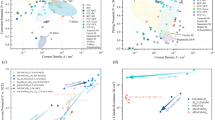Abstract
The main possible modes of the high-temperature corrosion of binary twophase alloys by a single oxidant under gas-phase pressures sufficient to corrode both alloy components are examined to highlight the differences in their behavior with respect to single-phase alloys. It is shown that in the absence of important diffusion processes of the metal components in the alloy the expected scale structures are significantly different from those typical of single-phase alloys. The effects due to the existence of different degrees of deviation from equilibrium as a result of kinetics hindrances for the formation of the most stable oxide and in the absence of alloy diffusion are then examined. It is also shown that when diffusion in the alloy becomes important the alloy may develop an outer single-phase layer depleted in the most-reactive component, which may lead to various possible scale structures. The conditions for the transition between the various oxidation modes as well as the effect of the various parameters of kinetics, thermodynamic and structural nature over the corrosion behavior of two-phase alloys are also examined.
Similar content being viewed by others
References
J. Stringer, P. S. Corkish, and D. P. Whittle, inStress Effects on the Oxidation of Metals, J. V. Catchard, ed. (Met. Soc. AIME, New York, 1975), p. 75.
G. Wang, B. Gleeson, and D. L. Douglass,Oxid. Met. 35, 343 (1993).
F. Gesmundo, F. Viani, Y. Niu, and D. L. Douglass,Oxid. Met. 40, 373 (1993).
F. Gesmundo, Y. Niu, F. Viani, and D. L. Douglass,Oxid. Met. 39, 197 (1993).
F. Gesmundo, Y. Niu and F. Viani,Oxid. Met., accepted for publication.
C. Wagner,J. Electrochem. Soc. 99, 369 (1952).
C. Wagner,Z. Elektrochem. 63, 772 (1959).
R. A. Rapp,Corrosion 21, 382 (1965).
F. Gesmundo and F. Viani,Oxid. Met. 25, 269 (1986).
P. Kofstad,High Temperature Corrosion (Elsevier Applied Science, London, 1988).
C. Wagner,J. Electrochenm. Soc. 103, 627 (1956).
A. Atkinson,Corros. Sci. 22, 87 (1982).
F. Gesmundo, P. Nanni, and D. P. Whittle,J. Electrochem. Soc. 127, 1773 (1980).
F. Gesmundoet al. (to appear).
C. Wagner,Ber. Bunsenges. Phys. Chem. 70, 775 (1966).
N. Birks and G. H. Meier,Introduction to High Temperature Oxidation of Metals (Arnold, London, 1983).
J. P. Orchard and D. J. Young,J. Electrochem. Soc. 133, 1734 (1986).
A. T. Fromhold,Theory of Metal Oxidation (North-Holland, Amsterdam, 1976), Vol. I, Chap. 4.
R. A. Rapp,J. de Phys. IV, C9, Suppl. toJ. de Phys. III,3, 1 (1993).
B. S. Lee and R. A. Rapp,J. Electrochem. Soc. 131, 2998 (1984).
W. H. Cheung and D. J. Young,Oxid. Met. 36, 15 (1991).
F. Gesmundo, F. Viani, and D. J. Young,Oxid. Met. 38, 309 (1992).
B. Gleeson, D. L. Douglass, and F. Gesmundo,Oxid. Met. 31, 237 (1989).
M. F. Chen, D. L. Douglass, and F. Gesmundo,Oxid. Met. 31, 237 (1989).
G. Wang, R. Carter, and D. L. Douglass,Oxid. Met. 32, 273 (1989).
R. V. Carter, D. L. Douglass, and F. Gesmundo,Oxid. Met. 31, 341 (1988).
M. F. Chen, D. L. Douglass, and F. Gesmundo,Oxid. Met. 32, 185 (1989).
B. Gleeson, D. L. Douglass, and F. Gesmundo,Oxid. Met. 33, 425 (1990).
F. Gesmundo, P. Nanni, and F. Viani,Proceedings of the 10th International Symposium on the Reactivity of Solids, P. Barret and L. C. Dufour, eds. (Elsevier, Amsterdam, (1985), vol. 28A, p. 175.
T. Hodgkiess, G. C. Wood, D. P. Whittle and B. D. Bastow,Oxid. Met. 14, 263 (1980).
T. B. Massalski, J. L. Murry, L. H. Bennett, and H. Baker, eds.Binary Alloys Phase Diagrams (ASM, Metals Park, 1986).
G. R. Wallwork,Rep. Progr. Phys. 39, 401 (1976).
C. Wagner,Corros. Sci. 8, 889 (1968).
Author information
Authors and Affiliations
Rights and permissions
About this article
Cite this article
Gesmundo, F., Viani, F. & Niu, Y. The possible scaling modes in the high-temperature oxidation of two-phase binary alloys. Part I: High oxidant pressures. Oxid Met 42, 409–429 (1994). https://doi.org/10.1007/BF01046758
Received:
Revised:
Issue Date:
DOI: https://doi.org/10.1007/BF01046758




